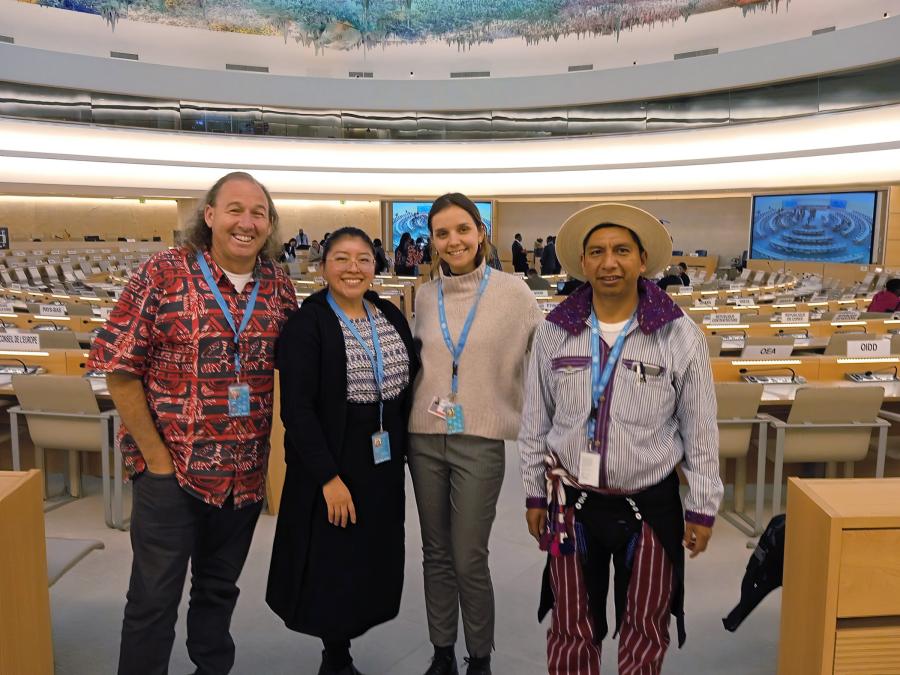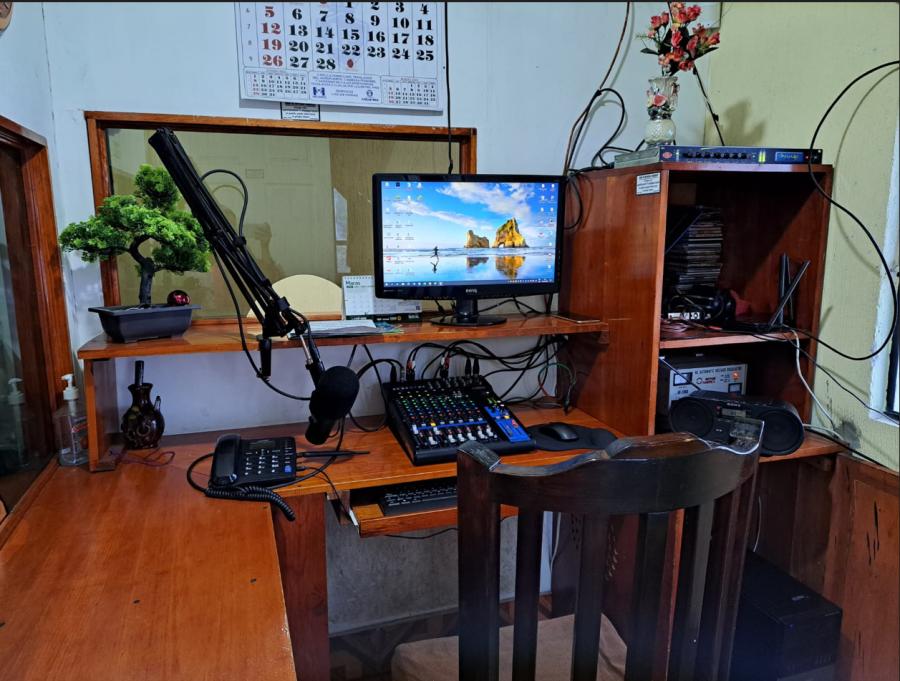Phase Two of Counterinsurgency in Guatemala has begun
In July and August of 1984, Vincent Flynn visited a number of highland Guatemalan communities. The following account describes new model villages located to the west of the Ixil center of Nebaj in the department of Quiché. Two model villages, Acul and Tzalbal, are already constructed, while a third, Salquil, is in the early stages of formation.
Acul and Tzalbal, along with the other Ixil model villages of Rio Azul, Xolcuay, Juil and a settlement outside of Chajul, were officially inaugurated at the end of July 1984, by Chief of State Oscar Humberto Mejía Victorés. Acul and Tzalbal comprise approximately 800 families and an equal number of houses. House construction was underwritten by BANVI, the Guatemalan housing bank, while labor was provided by the inhabitants through a food-for-work program. The two model villages I visited, like their twelve other counterparts in other parts of Quiché, Huehuetenango and the Verapaces, are part of an intense government campaign to concentrate the region's population.
The past decade has brought drastic changes to Ixil society. In 1972, the Guerrilla Army of the Poor (EGP) was formed in the Ixcán lowlands of Quiché, and guerrillas soon moved into the Ixil area to organize the population. Support for the guerrilla movement grew, and by the latter part of 1979, the EGP controlled considerable territory. The Guatemalan army found it difficult to recover the territory, because when the army attempted to move into the area, guerrillas would ambush them.
During the latter part of the Lucas García regime (1978-1982), the army changed its tactics. Chief of the Guatemalan army. General Benedicto Lucas García (brother of President Romeo Lucas García), used the expertise gained at France's St. Cyr military college, reorganized army strategy and implemented the civil patrol program. The army strategy consisted of destroying the guerrillas' support base by publicly executing villagers and massacring several entire communities.
In Quiché, the army successfully drove the guerrillas from the main population centers. During the counterinsurgency sweeps of 1981-1983, however, thousands of civilians were killed, tens of thousands fled their homes, and nearly every dwelling and public building in the Ixil region, outside of the main population centers of Nebaj, Chajul, and Cotzal, was burned by the army or civil patrol units. When the area was deemed safe for repopulation, the army began a second pacification phase.
Senior army commanders of the Quiché insist that nucleating the population serves two purposes. First, it controls the population - and "protects the people from the guerrillas to assure that they do not again become duped by the forces of subversion." Second, it facilitates the delivery of services under an ambitious program of economic development designed to win the hearts and minds of the civilians.
Housing, water, electricity, road construction, health care, experimental agricultural plots and craft production are visible aspects of this economic development program. All dimensions of material reconstruction and economic development are handled by various government agencies that work together through "inter-institutional coordinating committees" which function at a national, regional and municipal level. The army has considerable input at each level; as a senior army commander explained, "The key to reconstruction is "integral development'."
A new road links the model villages of Acul and Tzalbal with Nebaj. The Guatemalan Corps of Engineers is responsible for the project. The Corps uses heavy equipment instead of relying on the physical labor of local civilians in order to complete the road quickly. Progress is substantial; the road from Tzalbal, begun in February, already extends four kilometers. The effort nevertheless is hampered by heavy rainfall that saturates the soil and causes erosion. The road is to be extended to Barrillas, Huehuetenango, through the burned out Ixil communities of Palob and Sumal, which are also stated to become new model villages.
There are few civilians working on road construction, so the guerrillas who remain in the hills constantly harass the army construction crew. Two weeks after I left the region, guerrillas killed 17 army road construction workers.
With a companion journalist, I accompanied a civil patrol to Río Sichel. There we met an army platoon that took us to Salquil. Salquil is considered a "town in formation," because although it is not yet a model village, it is to become one. Salquil at present is a refugee camp that at the time of the visit held approximately 2,000 people.
From Tzalbal we walked the four kilometers to the end of the completed road. Erosion had already taken its toll; in its present condition the road will not last many years.
The new town of Salquil is located on a saddleback hill about one kilometer northwest of the old town center. The burned out shells of the church, auxiliary municipal building and numerous houses stand as testimony to recent Salquil history. The physical evidence is disappearing quickly, however, as resettled villagers scavenge the ruins of burned out buildings for construction materials. Charred wooden beams, boards and tile supplement the ubiquitous straw and cornstalk construction in the refugee camp.
The refugees in Salquil are mostly former inhabitants of the old town. By August 1982, many had fled their homes and hid in the hills for over a year during army campaigns. A number were rounded up by the army and eventually taken to the refugee settlement of La Pista, or "Ak Tzumbal," outside Nebaj. Under the leadership of an evangelical pastor, another group of refugees descended from the hills to Nebaj. The army resettled most of them in Salquil in February 1984.
The army established a small garrison at Salquil in January of 1984, and soon began to resettle the villagers who had been at La Pista. A few came voluntarily, but for the most part, they were rounded up in the hills by army and civil patrol units. The army base in Salquil, consisting of approximately 100 soldiers, sits above the villagers' crude shelters. Army commanders told me that Salquil will become a model community once the road reaches there and supplies can be brought in.
The basic pattern of army pacification in the region is for the army to establish a garrison in hostile territory and then send patrols to rout out members of the civilian population who are living in the hills. Often, the rounding up of civilians is done in conjunction with civil patrol units from other communities. At the time of my visit, patrol units from Tzalbal were undertaking patrols in the Salquil area. Many of the men in Salquil are still too weak to go out on such patrols. Moreover, the army commanders are not yet convinced of their loyalty.
From Salquil it is possible to see the "uncommitted" Ixil civilians across the valley. Soldiers say that the "uncommitted" feed the guerrillas and that the way to commit the people and get them to come into the settlement is to destroy their crops. In fact, much of the food used to feed the refugees in Salquil comes from army forays into guerrilla-held land. For example, although the first refugees arrived in Salquil in February 1984, the first shipment of food from the Committee of National Reconstruction (CRN) did not arrive in the community until six months later.
We stayed overnight with the soldiers and talked with a number of them at length. They are crack troops, well trained and disciplined; and, most interestingly, they are all ladino, with the exception of one or two indigenous inscriptees who serve as translators.
These well trained soldiers are placed in Salquil by design. Their military preparedness is essential to defeat the remaining elusive guerrillas. More importantly, however, the soldiers were selected for the establishment and control of model communities and the erection of showcase examples of counterinsurgency.
There was considerable control over the movements of the civilian population in Salquil. The camp/garrison complex was virtually surrounded by guerrilla-held territory and there were almost daily attacks by guerrillas directed at the army base or at soldiers traveling to or from Tzalbal. Villagers who wish to travel must present legitimate reason for traveling, and then soldiers often accompany them to other "safe" villages or to the "enemy's corn fields," as one soldier put it.
Salquil, as a model village in formation, provides a clear picture of Guatemala's counterinsurgency tactic: the guerrillas and their support base were devastated by the brutal tactics of the Lucas Garcia and, later, the Ríos Montt regimes. Once the civilian population was uprooted through the use of terror, strategic nuclei were established around which the population could be resettled. Crack troops set up formidable bases and conducted frequent forays to round up civilians from the hills and to track down the remaining guerrillas.
Refugees insisted that civil patrols arrived at their hamlets when the men were working in the fields. By taking the women and children first, the army ensured that the men followed their relatives to the refugee camps. Many men resisted going to the camps for more than a year. They hesitated to go, they said, because the guerrillas told them the army would kill them. One senior army officer in the region said that the refugees come to their side out of pure hunger, and that the army was now winning the "war of hunger."
The army plans to extend its sphere of influence westward to Barrillas, which is in the jurisdiction of the Huehuetenango military command. The road will, in part, accomplish this linkage, but more importantly, new bases will clear the way to establish "safe zones" in the midst of guerrilla territory. The dispersed population of "uncommitted" Ixil Indians will be nucleated into refugee camps, with plans to create from these camps more model villages. The army views these zones as little oases, from which control over the countryside can be extended. Palob and Sumal, to the west of Tzalbal, are stated to become future model villages.
Army commanders in the area see their role as that of development officers. They complain that for centuries Ixil Indians had been ignored by Guatemalan society and the government. It is for this reason, they insist, that guerrillas were able to persuade the people to join them. Now that the civilian population has been wrested from the guerrillas, he feels that the Ixil people finally are embarking on a new development phase, one that has long been overdue.
Like most Guatemalan army officers who direct Guatemala's new development schemes, these views ignore the reality of the highlands. Four hundred and fifty years after the Spanish Conquest and the forceful nucleation of indigenous peoples through the policies of reducción and congregación, the army today is implementing an almost identical program. Even the reasons are the same. The aim of the model village program is to control the Indians, to civilize them and to bring them into the fold of the larger national system. This civilizing measure is ultimately intended to forestall the intrusion of "foreign and alien ideologies" (e.g., Communism) into the minds of the Ixil people.
Article copyright Cultural Survival, Inc.


